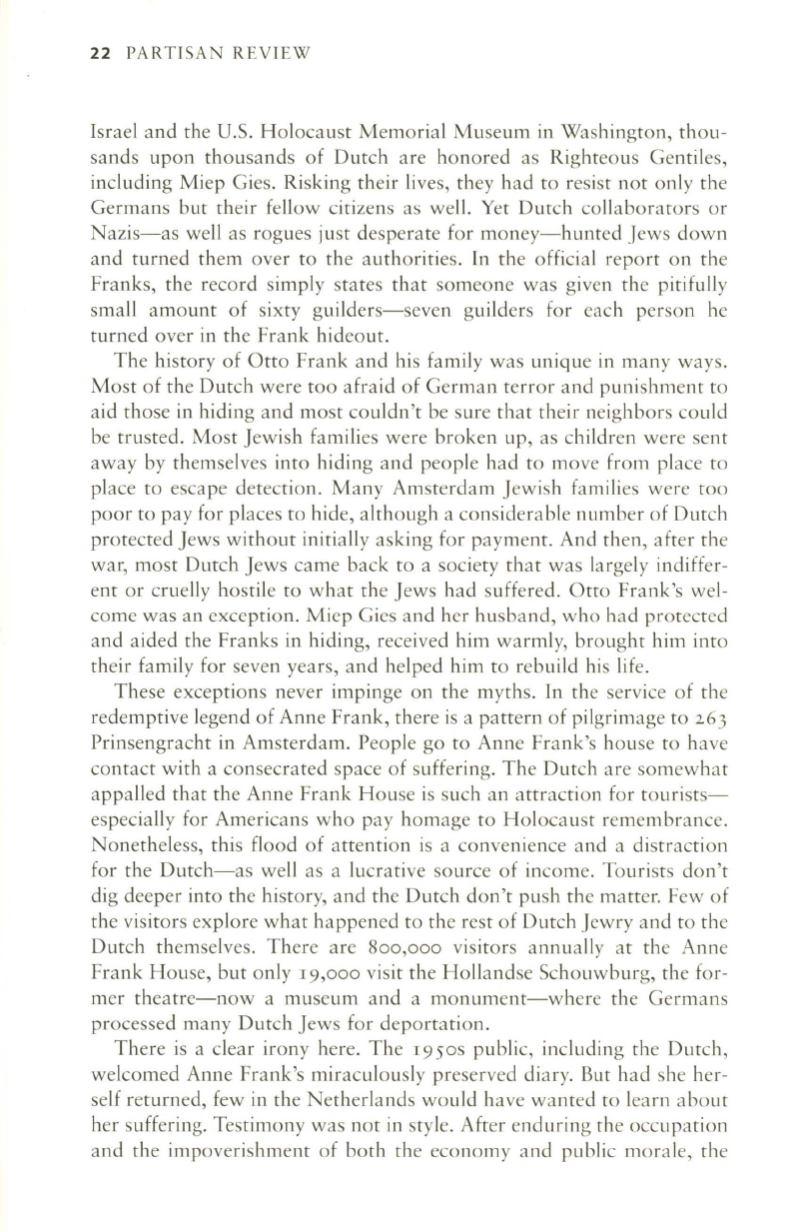
22
PARTISAN REVI EW
Israel and the U.S. Holocaust Memorial Museum in Washington, thou–
sands upon thousands of Dutch are honored as Righteous Gentiles,
including Miep Gies. Risking their lives, they had to resist not only the
Germans but their fellow citizens as well. Yet Dutch collaborators or
Nazis-as well as rogues just desperate for money-hunted Jews down
and turned them over to the authorities.
In
the official report on the
Franks, the record simply states that someone was given the pitifully
small amount of sixty guilders-seven guilders for each person he
turned over in the Frank hideout.
The history of Otto Frank and his family was unique in many ways.
Most of the Dutch were too afraid of German terror and punishment to
aid those in hiding and most couldn't be sure that their neighbors could
be trusted. Most Jewish families were broken up, as children were sent
away by themselves into hiding and people had to move from place to
place to escape detection. Many Amsterdam Jewish families were too
poor to pay for places to hide, although a considerable number of Dutch
protected Jews without initially asking for payment. And then, after the
war, most Dutch Jews came back to a society that was largely indiffer–
ent or cruelly hostile to what the Jews had suffered. Otto Frank's wel–
come was an exception. Miep Gies and her husband, who had protected
and aided the Franks in hiding, received him warmly, brought him into
their family for seven years, and helped him to rebuild his life.
These exceptions never impinge on the myths.
[n
the service of the
redemptive legend of Anne Frank, there is a pattern of pilgrimage to
263
Prinsengracht in Amsterdam. People go to Anne Frank's house to have
contact with a consecrated space of suffering. The Dutch are somewhat
appalled that the Anne Frank House is such an attraction for tourists–
especially for Americans who pay homage to Holocaust remembrance.
Nonetheless, this flood of attention is a convenience and a distraction
for the Dutch-as well as a lucrative source of income. Tourists don't
dig deeper into the history, and the Dutch don't push the matter. Few of
the visitors explore what happened to the rest of Dutch Jewry and to the
Dutch themselves. There are
800,000
visitors annually at the Anne
Frank House, but only
19,000
visit the Hollandse Schouwburg, the for–
mer theatre-now a museum and a monument-where the Germans
processed many Dutch Jews for deportation.
There is a clear irony here. The
1950S
public, including the Dutch,
welcomed Anne Frank's miraculously preserved diary. But had she her–
self returned, few in the Netherlands would have wanted to learn about
her suffering. Testimony was not in style. After enduring the occupation
and the impoverishment of both the economy and public morale, the


